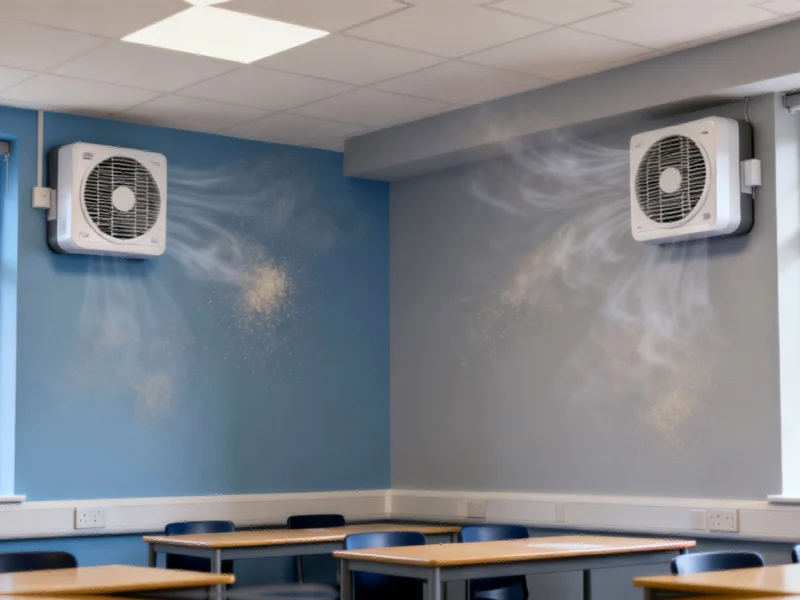Major Investment in Classroom Air Filtration
In a groundbreaking move for urban education and public health, London has launched a £2.7 million initiative to install advanced air filtration systems in hundreds of schools across the capital. The comprehensive program, announced by Mayor Sir Sadiq Khan, represents one of the most significant investments in educational environmental health in recent European history.
Speaking at St Mary’s RC Primary School in Battersea, one of the first institutions to benefit from the new technology, Sir Sadiq emphasized the transformative potential of the initiative. “This isn’t just about cleaner air—it’s about giving our children the healthy start they deserve,” he stated, highlighting research showing the filters could reduce harmful particulate matter (PM2.5) inside classrooms by up to 68%.
The Science Behind Classroom Air Quality
Particulate matter, particularly PM2.5, represents one of the most significant environmental health threats in urban educational settings. These microscopic particles, measuring 2.5 micrometers or smaller, can penetrate deep into lung tissue and even enter the bloodstream. Children are especially vulnerable due to their developing respiratory systems and higher breathing rates relative to their body size.
The new filtration systems employ multi-stage technology that captures everything from coarse dust to ultrafine particles. This approach mirrors industry developments in environmental technology that are increasingly focusing on comprehensive solutions rather than single-approach systems.
Political and Environmental Context
While the initiative has received widespread support, it exists within a complex political landscape. The City Hall Conservatives acknowledged the benefits for air quality but raised concerns about potential countermeasures, including the removal of congestion charge exemptions for electric vehicles.
This tension reflects broader challenges in urban environmental policy, where multiple initiatives must be balanced to achieve comprehensive results. The situation demonstrates how market trends in urban sustainability often involve complex trade-offs between different environmental priorities.
Broader Implications for Urban Health
London’s school filtration program establishes an important precedent for other major cities grappling with air quality challenges. The initiative comes at a time when urban air filtration systems are becoming increasingly sophisticated, incorporating smart monitoring and adaptive filtration technologies.
Educational experts note that improved air quality could have far-reaching benefits beyond physical health. Recent studies suggest that better indoor air quality correlates with improved cognitive function, concentration, and academic performance among students. These findings align with related innovations in educational environment optimization that are gaining traction globally.
Technological Integration and Future Applications
The implementation of advanced filtration systems in London schools represents a significant step in the integration of environmental technology into public infrastructure. As cities worldwide confront similar challenges, the data and experience gained from this initiative could inform future urban planning decisions.
This development occurs alongside significant recent technology advancements across multiple sectors, including the rapid adoption of sophisticated monitoring systems in various applications. The parallel progress in different technological domains suggests a broader pattern of innovation addressing complex modern challenges.
Implementation Timeline and Expected Outcomes
The rollout will initially target more than 200 schools identified as being in areas with particularly poor air quality. Implementation will occur in phases, with monitoring systems tracking air quality improvements and potential impacts on student health and attendance.
Early data from pilot programs suggests the initiative could deliver substantial benefits, potentially reducing respiratory problems and asthma exacerbations among vulnerable students. The comprehensive approach reflects growing recognition of indoor air quality as a critical component of public health infrastructure, mirroring concerns about security in other digital domains highlighted by the LastPass phishing scam alert that emphasized the importance of proactive protection measures.
Global Context and Comparative Initiatives
London’s program places it at the forefront of a global movement addressing educational environmental quality. Similar, though typically smaller-scale, initiatives have emerged in other major cities, but the scope and funding of London’s approach represent a significant escalation in governmental response to urban air quality challenges.
This focus on environmental quality in educational settings coincides with other technological adoption patterns, such as the remarkable market response demonstrated by Apple’s iPhone Air selling out instantly in China, indicating consumer appetite for advanced technological solutions across multiple domains.
Long-term Vision and Sustainability
The air filtration initiative forms part of London’s broader strategy to become one of the world’s most sustainable megacities. By addressing environmental health in educational settings, the program aims to create lasting benefits that extend beyond immediate air quality improvements.
This comprehensive approach to urban environmental management reflects similar patterns in other sectors, where integrated solutions are increasingly favored over isolated interventions. The strategy aligns with evolving technology adoption trends that emphasize holistic benefits rather than single-feature advantages.
As the program progresses, it will provide valuable data on the relationship between environmental interventions and educational outcomes, potentially influencing policy decisions in cities worldwide facing similar air quality challenges.
The successful implementation of this initiative could establish new standards for environmental protection in educational settings, demonstrating how technological solutions can address critical public health challenges in urban environments.
This article aggregates information from publicly available sources. All trademarks and copyrights belong to their respective owners.

